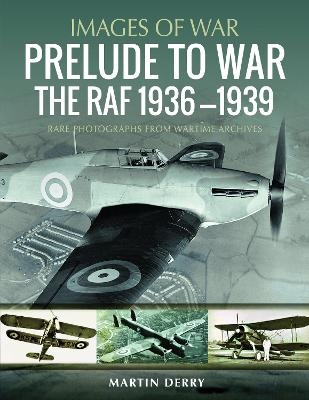
Prelude to War: The RAF, 1936–1939
Rare Photographs from Wartime Archives
Seiten
2020
Air World (Verlag)
978-1-5267-5482-0 (ISBN)
Air World (Verlag)
978-1-5267-5482-0 (ISBN)
Showcases images of biplane fighters, such as the Hawker Fury, the Hawker Hart and the Gloster Gladiator, as well as monoplane fighters, including the Hurricane I, the Spitfire, and the Vickers Venom.
Through the use of contemporary photographs and informative captions, _Prelude To War: The RAF 1936-1939_ chronicles many of the RAF's aircraft that continued to serve in the years immediately preceding the start of hostilities in 1939, a period of rapid technological change and mechanical innovation at a time when many European nations held their collective breath as, yet again, they witnessed the steady rise of German militarism and, ultimately, conquest.
Forced to take note of this emerging threat the British government authorised a policy of modernising and re-equipping Britain's armed forces. This process, frequently confusing and fitful, was by 1936 taking shape with the RAF at the forefront of modernisation, although as Winston Churchill solemnly noted in 1937, It was no longer in our power to forestall Hitler or to regain air parity. Nothing could now prevent the German Army and the German Air Force from becoming the strongest in Europe we could only improve our position. We could not cure it'.
To this day, isolated perceptions still linger to the effect that by September 1939 the RAF had become an all-monoplane force with Fighter Command fielding countless squadrons of Hurricanes and Spitfires ready to overwhelm any enemy insolent enough to enter British skies. Similarly, the same perceptions suggest that a confident Bomber Command stood ready to darken German skies with armadas of modern bombers. These notions were wide of the mark - such was the power of propaganda!
Certainly, numbers of monoplanes did exist, but until the aircraft industry could expand to cope with the demands of a modern war, fleets of obsolescent biplanes had to be employed in secondary roles, with others remaining in the frontline until monoplanes could replace them: there was no other choice.
It is hoped that this modest work will shed light on some of the RAF's better known aircraft of the period, but more particularly upon those that remain virtually unknown today and which might be described as having also ran'.
Through the use of contemporary photographs and informative captions, _Prelude To War: The RAF 1936-1939_ chronicles many of the RAF's aircraft that continued to serve in the years immediately preceding the start of hostilities in 1939, a period of rapid technological change and mechanical innovation at a time when many European nations held their collective breath as, yet again, they witnessed the steady rise of German militarism and, ultimately, conquest.
Forced to take note of this emerging threat the British government authorised a policy of modernising and re-equipping Britain's armed forces. This process, frequently confusing and fitful, was by 1936 taking shape with the RAF at the forefront of modernisation, although as Winston Churchill solemnly noted in 1937, It was no longer in our power to forestall Hitler or to regain air parity. Nothing could now prevent the German Army and the German Air Force from becoming the strongest in Europe we could only improve our position. We could not cure it'.
To this day, isolated perceptions still linger to the effect that by September 1939 the RAF had become an all-monoplane force with Fighter Command fielding countless squadrons of Hurricanes and Spitfires ready to overwhelm any enemy insolent enough to enter British skies. Similarly, the same perceptions suggest that a confident Bomber Command stood ready to darken German skies with armadas of modern bombers. These notions were wide of the mark - such was the power of propaganda!
Certainly, numbers of monoplanes did exist, but until the aircraft industry could expand to cope with the demands of a modern war, fleets of obsolescent biplanes had to be employed in secondary roles, with others remaining in the frontline until monoplanes could replace them: there was no other choice.
It is hoped that this modest work will shed light on some of the RAF's better known aircraft of the period, but more particularly upon those that remain virtually unknown today and which might be described as having also ran'.
After leaving Midland County Publications, Martin Derry has been involved with compiling, editing, assisting with and subsequently writing aviation-related books for fifteen years or more, initially with Dalrymple and Verdun Publishing, Crecy and, since 2012, with Pen & Sword for whom he has written several of their _Flight Craft_ series of books with the nostalgist and modeller in mind - Martin currently has other titles in preparation.
| Erscheinungsdatum | 21.09.2020 |
|---|---|
| Reihe/Serie | Images of Aviation |
| Zusatzinfo | 225 black and white illustrations |
| Verlagsort | Barnsley |
| Sprache | englisch |
| Maße | 189 x 246 mm |
| Themenwelt | Geschichte ► Allgemeine Geschichte ► 1918 bis 1945 |
| Geschichte ► Teilgebiete der Geschichte ► Militärgeschichte | |
| Sozialwissenschaften ► Politik / Verwaltung | |
| ISBN-10 | 1-5267-5482-7 / 1526754827 |
| ISBN-13 | 978-1-5267-5482-0 / 9781526754820 |
| Zustand | Neuware |
| Informationen gemäß Produktsicherheitsverordnung (GPSR) | |
| Haben Sie eine Frage zum Produkt? |
Mehr entdecken
aus dem Bereich
aus dem Bereich
ein Psychologe erlebt das Konzentrationslager
Buch | Hardcover (2024)
Kösel (Verlag)
CHF 30,80
Mythos „Stauffenberg-Attentat“ – wie der 20. Juli 1944 verklärt und …
Buch | Hardcover (2024)
Goldmann (Verlag)
CHF 33,55


